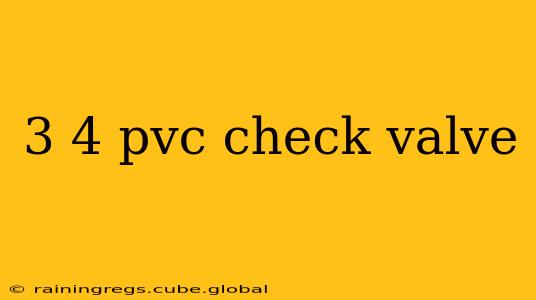Finding the right check valve for your plumbing or irrigation system can feel overwhelming. This guide focuses specifically on 3/4" PVC check valves, exploring their applications, types, installation, and troubleshooting. We'll cover everything you need to know to make an informed decision.
What is a 3/4" PVC Check Valve?
A 3/4" PVC check valve is a one-way valve made from polyvinyl chloride (PVC) pipe, designed to allow fluid flow in only one direction. It prevents backflow – the unwanted reversal of fluid flow – in pipelines carrying water, chemicals, or other liquids. The 3/4" refers to the nominal pipe size, meaning the valve is designed to fit standard 3/4" PVC pipes. This size is common in residential and light commercial applications.
Types of 3/4" PVC Check Valves
Several types of 3/4" PVC check valves exist, each with its own characteristics and applications:
Swing Check Valves:
These are the most common type. They utilize a hinged disc or flap that swings freely to allow forward flow. When backflow occurs, the disc closes, sealing off the pipe. They are relatively inexpensive and simple to install.
Ball Check Valves:
These valves use a free-floating ball to control flow. The ball sits in a seat, allowing forward flow. Backflow forces the ball against the seat, preventing reverse flow. They are generally more compact than swing check valves.
Lift Check Valves:
These valves use a disc or flapper that is lifted by the flow of liquid. When flow reverses, the disc or flapper drops, blocking the flow. They are less common in 3/4" sizes for residential use.
Where are 3/4" PVC Check Valves Used?
3/4" PVC check valves find applications in various settings:
- Residential Plumbing: Preventing backflow in water supply lines, sump pumps, and irrigation systems.
- Irrigation Systems: Protecting pumps and preventing water from draining back into the source.
- Chemical Transfer Lines: Controlling the flow of chemicals in industrial and agricultural settings.
- Other applications: Any system needing unidirectional flow control.
How to Install a 3/4" PVC Check Valve
Installing a 3/4" PVC check valve is typically straightforward:
- Cut the pipe: Carefully cut the PVC pipe where the check valve will be installed.
- Prepare the pipe: Use a deburring tool to remove any sharp edges from the cut pipe. This prevents damage to the valve and ensures a proper seal.
- Apply PVC cement: Apply a thin, even layer of PVC cement to the ends of the pipe and the valve sockets.
- Insert the valve: Carefully insert the valve into the pipe, ensuring a snug fit.
- Hold securely: Hold the valve in place for a few minutes to allow the cement to set.
Always refer to the manufacturer's instructions for specific installation details.
Troubleshooting 3/4" PVC Check Valves
If your 3/4" PVC check valve isn't functioning correctly, here are some common issues and solutions:
The valve leaks:
- Check the seal: Ensure the valve is properly seated and that there are no cracks or damage to the valve body or seals.
- Check the cement: Poorly applied PVC cement can lead to leaks. If the cement isn't properly cured, it may need to be redone.
- Damaged parts: Replace the faulty valve.
The valve won't close:
- Debris: Accumulated debris can sometimes interfere with the valve's operation. Try flushing the line to remove any debris.
- Valve damage: A damaged internal component (disc, ball, flapper) may prevent proper closing. Replace the valve if this is suspected.
- Low water pressure: In some cases, extremely low pressure may prevent the valve from fully closing.
What size check valve do I need?
The size of the check valve should match the size of your pipe. Using an improperly sized valve can lead to flow restrictions or leaks. In this case, you need a 3/4" check valve.
How do I choose the right check valve?
Selecting the right check valve depends on factors such as the type of fluid being transported, the pressure within the system, and the required flow rate. Refer to manufacturer's specifications and consider the above-discussed valve types to make the most appropriate selection.
This comprehensive guide provides a solid foundation for understanding and utilizing 3/4" PVC check valves. Remember to always prioritize safety and consult relevant professional resources when working with plumbing systems.
